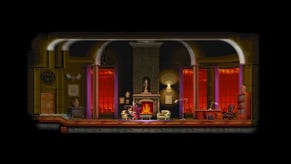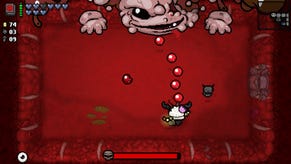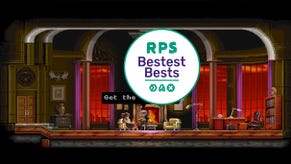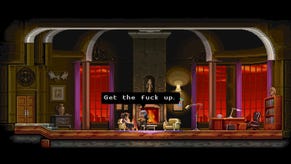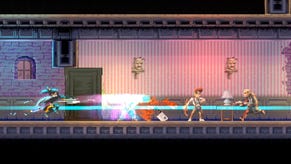How Katana Zero brought action into cutscenes
Worth a thousand words
When a game’s cutscene begins and the dialogue starts spooling, I can’t help it. My phone comes out and I’m scrolling. From being active I’ve suddenly become passive, and rather than stay engaged, my brain impulsively turns to Twitter, Reddit, anything, to feed its pathetic desire for reward through light interaction.
But I don’t during Katana Zero’s cutscenes. When this action game halts its razor-fine combat to tell you its story, I sit forward. That’s down to its interrupt system, which lets me choose whether I want to hear NPCs out, or whether I want to tell them to shut up. “I honestly hope more games adopt the interrupt system, if nothing else because it just feels like a much better way to tell stories,” developer Justin Stander tells me. “It’s less reading and more doing.”
Katana Zero’s interrupt system introduces a light dose of interaction to dialogue, and this simple idea instantly feels better suited to the fast pacing of an action game than the pages of back and forth conversation that we’re all used to. It’s so important to the game that Graham led with it in his review. And that’s exactly what it was intended to do.
“It came from me wanting to fix one of the biggest problems that I found in action games and videogame cutscenes in general,” Stander says. “It’s the unstoppable cutscene, or cutscenes where you feel you have no agency. Taking complete control away from the player and making them read something, it takes away from the pacing a huge amount.”
Here’s how it works. When an NPC starts talking, a time bar appears below the scene and begins filling, first in red, with a single choice below. During this state, you can interrupt, forcing on the conversation a choice which generally means, “GO AWAY.” Hear the NPC out, though, and you’ll get a set of new choices that will progress the conversation in a different way. Let the time bar fill to the top and it’ll select whichever choice you have highlighted. The result is a dialogue system in which you can always make a choice.
Katana Zero also features incidental dialogue between NPCs, which you interrupt by, well, interrupting them. “It was nice, being able to make these little vignettes that didn’t have to be a big showstopping part of the game,” said Stander. ”They meant I could be way more stupid with them and more in-depth than a regular cutscene because they didn’t matter; if the player didn’t want to watch them then they could just run in and kill them, and I didn’t feel bad for breaking my own design principle of only putting cutscenes in drive the plot forward.”
Stander didn’t originally conceive Katana’s Zero’s dialogue system for an action game. Instead, he created it for an ambitious-sounding RPG project, which rode on the concept of having no limits. At any time, you’d be able to enter a tactical mode in which you could fight quest-critical NPCs and shopkeepers and interact with any object without the game getting in the way. “But with full repercussions, almost GTA-style,” Stander says. “I wanted to fix RPGs in the sense that I really don’t like limiting factors in videogames.“
To maintain the same sense of open possibility, he designed a dialogue system that’d allow you to walk away as an NPC is talking, or to interrupt them with a line of your own. “Or even just shoot them by going into tactical mode while talking. It was an attempt to make things feel as natural and give players as much freedom as possible, because I always find while playing a game, the coolest thing is exploiting the systems and doing whatever you want.”
You might not be surprised to hear that he shelved that RPG. But he brought its dialogue system across to the action game that became Katana Zero. There it found a new purpose, to maintain the momentum of action scenes by keeping you thinking, considering the effect of interrupting and what it might cause.
The dialogue system is easy to understand and use, but there’s more nuance to it than it might first appear. One of the aspects that required a lot of tuning was the timing of the bar between its interrupt and response phases. The worst thing, Stander found, was watching playtesters accidentally picking responses because either they interrupted too late and picked the first choice response, or picked a choice too late and interrupted the next line of dialogue.
”So I had to program in a certain level of leniency, to make sure people’s responses were what they wanted, and to make sure they have enough time to theoretically read all the responses, or at least some of them, before they make a choice.”
The solution, it turns out, is similar to the ‘coyote time’ trick that Stander uses in Katana Zero’s platforming design. It's a common technique - I wrote a bit about it when I looked at Celeste - but coyote time is essentially about giving players a brief grace period to account for their intention, a moment when you can still jump after you've already past the edge of a platform.
“Pretty much every time there’s a state change in the text box there’s a buffer period where the game doesn’t want to take inputs because you’re too close to the change. It thinks that you might not choose the right thing. I took the things I learned about getting the best possible player input in the platforming segment and applied them elsewhere.”
For Katana Zero, it means that if you press to interrupt but the timer has just switched to standard responses, you’ll get the interrupt because the game lends a five-frame grace period. (Incidentally, if you kill someone just after they shoot bullets at you, the game pretends they were never shot. “It makes it seem more fair.”)
There are other subtle tricks that help the dialogue system work on a player level. Stander was careful to reduce the stakes of any one choice, because he doesn’t like many games’ tendency to throw single big game-changing decisions at players. “I wanted to take away all the stress and make it feel more organic, in that all the choices are extremely small, and even the ones that seem big will peter out or resolve themselves,” he explains.
For example, there's a sequence in which the main antagonist, V, asks for your sword. If you give it to him, you won’t have it at the beginning of the level, so you have to beat it by using only throwable items. Then your sword is restored to you. The result is that the game feels reactive to your choices, but you’re generally not lumbered with their ramifications, only experiencing interesting wrinkles.
“It’s a Walking Dead thing, right? In those games players are constantly given small choices that change the overall outcome, and I thought it’s a much better system.”
But still, the game tries to bring attention to major choices with character animation, aiming to convey the context so you get a sense of its import. In fact, the game works hard across the board to make the important parts of its story instantly clear. It uses colour to draw the eye to the most important parts of the text, and it animates text to give it evident emotion. Wavy purple text gives a sense of a character who’s aloof or scared. Red quivering text is angry. Unmoving red text is menacing or stern. Stander also used colour during the interrupt phase, presenting the UI and text in red to give an immediate air of caution.
Katana Zero’s text is therefore very scannable, its meaning leaping out as it appears and letting you make quick decisions. At least, that’s how it’s turned out - its colours and animation actually started out as a way of avoiding blandly featureless text boxes. “I felt that if I was going to put an extreme level of polish into everything then skimping on text is the worst thing to do,” says Stander. And then he realised its potential.
And then he got playful. Inside his technical implementation of text he added the ability to tag points in the script so they could affect other parts of the game. They serve as a simple way of scripting cutscenes, so when the text hits a tag, a character will play an animation or you’re given a liberal dose of screenshake. But they also let Stander achieve things like the sequence when you meet an assassination target called DJ Electrohead. Minor spoiler warning from now until the end of the paragraph: if you choose to hear the poor IDM star out and decide to take his side, a tag will trigger a sniper to headshot him and send his final words shattering outwards.
Dialogue tags also handle more complex moments, such as when the text runs into hallucinations and screen glitches and sends you suddenly into a bar scene and halfway through another dialogue you’ve seen before. Katana Zero’s text dialogue, which in many other games is their most mundane feature, turned out to deliver not only the words of its comic book story, but also govern a lot of its experiential flavour.
”I always tried to put the player into a comfortable rhythm and then pull the rug out from them when they’re comfortable,” says Stander. “I did that inside the dialogue system itself, with forced choices and glitches and dialogue boxes expiring when you expect to be able to make a choice. But more than anything, the dialogue system is a tool to help convey all the mind-fuckery of the plot.”
And yet Katana Zero remains a pure action game, something the simple choice-driven immediacy of its storytelling does a great deal to support. As a measure of how confident Stander eventually felt about it, he’d originally planned an option that would remove all cutscenes from the game. “ I felt there’d be a lot of people wanting to play just for the action and would hate being bogged down by them,” he says.
But as he continued to work on the game he realised just how much he’d fine-tuned its storytelling for action. “We really boiled down every text box and every plot point so it was as animated as possible, to have as little text as possible and to have as much choice as possible.” That option is in the game, but it’s specifically labelled for speedrunners.



